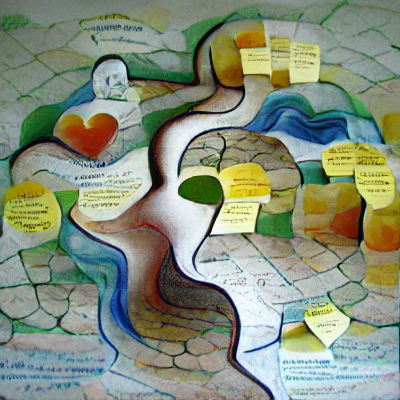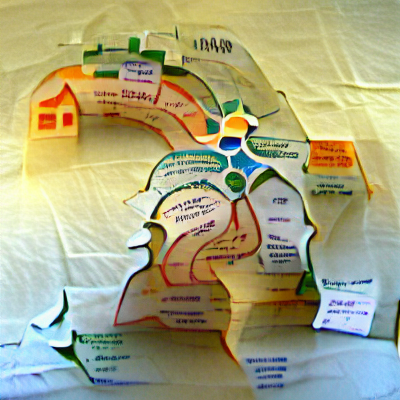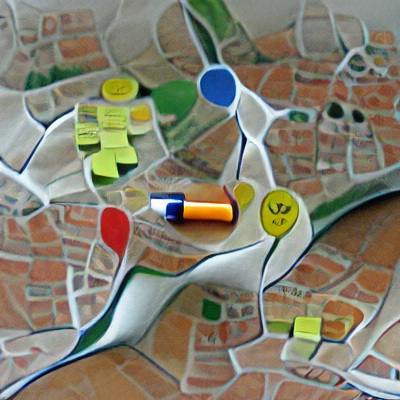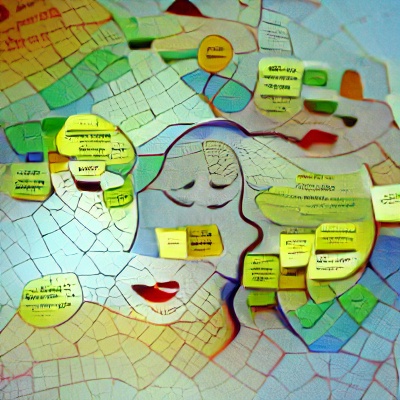Research
Foundations of Mental Health Mapping
 What constitutes a disorder and what is healthy or normative, especially if the disorder is a consequence of unwholesome mental states, can be unclear. We explore the foundations of what constitutes health, disorder, or disease and explore questions such as: What is healthy? What is the right reference group to compare disease with? Can we utilize systematic explorations of the mind as tools to understand it? In the long run, this work contributes to the theoretical foundation of mental health mapping, incorporating first and third person perspectives. We work together with philosophers, clinicians and patients who provide insights into clinical practice and inform our science in theoretical and practical ways.
What constitutes a disorder and what is healthy or normative, especially if the disorder is a consequence of unwholesome mental states, can be unclear. We explore the foundations of what constitutes health, disorder, or disease and explore questions such as: What is healthy? What is the right reference group to compare disease with? Can we utilize systematic explorations of the mind as tools to understand it? In the long run, this work contributes to the theoretical foundation of mental health mapping, incorporating first and third person perspectives. We work together with philosophers, clinicians and patients who provide insights into clinical practice and inform our science in theoretical and practical ways.
Structures of Mental Health Mapping
 Mental disorders are heritable (passed down through generations in families), comorbid, and heterogenous. Sometimes an impaired biology in a single individual is the structure underlying illness, in other cases the psychodynamics between individuals, groups or different parts of society as well as environmental stressors. We are guided by questions such as what makes one sibling with a disorder different from another who is healthy? What are the interpersonal factors contributing to mental health in families? When does it make sense to treat a group of individuals instead of the individual patient? What is the role of society and which policies, and treatments are improving our mental health? We work on large scale studies that contain necessary data for answering these questions and collaborate with scientists and clinicians.
Mental disorders are heritable (passed down through generations in families), comorbid, and heterogenous. Sometimes an impaired biology in a single individual is the structure underlying illness, in other cases the psychodynamics between individuals, groups or different parts of society as well as environmental stressors. We are guided by questions such as what makes one sibling with a disorder different from another who is healthy? What are the interpersonal factors contributing to mental health in families? When does it make sense to treat a group of individuals instead of the individual patient? What is the role of society and which policies, and treatments are improving our mental health? We work on large scale studies that contain necessary data for answering these questions and collaborate with scientists and clinicians.
Markers for Mental Health Mapping
 The factors underlying mental health or disorder are not well understood and a complex web of biological and non-biological variables interact producing symptoms in any given individual. This is one of the reasons why we have limited insights into the markers linked to illness. Through multimodal approaches we aim to detect hidden factors underlying illness and are guided by questions such as what makes one person different from another when diagnosed with the same disorder? How can we uncover predictive markers for illness? Which data modalities are informative for which disorder or disease process? We work together with scientists and clinicians interested in different disorders and diseases.
The factors underlying mental health or disorder are not well understood and a complex web of biological and non-biological variables interact producing symptoms in any given individual. This is one of the reasons why we have limited insights into the markers linked to illness. Through multimodal approaches we aim to detect hidden factors underlying illness and are guided by questions such as what makes one person different from another when diagnosed with the same disorder? How can we uncover predictive markers for illness? Which data modalities are informative for which disorder or disease process? We work together with scientists and clinicians interested in different disorders and diseases.
Models for Mental Health Mapping
 Most of the research directions described above involve machine learning tools. Therefore, we apply and develop these approaches for large scale imaging, electrophysiological, genetic, sensor, cognitive and behavioural data. Our methods are adapted to high dimensional data and often very unreliable labels. Our work is guided by questions such as how can we utilize machine learning across modalities? What methods are best to parse heterogeneity? Which longitudinal modelling procedures are suited to deal with the properties of the underlying data structures? How can we increase the interpretability of our models and ultimately how can we take machine learning from the lab to clinical practice? We work together with scientists working on innovative data acquisition methods and are interested in method development (e.g., machine learning, statistics) as well as in establishing best practices in curating complex, large datasets required for our research agenda.
Most of the research directions described above involve machine learning tools. Therefore, we apply and develop these approaches for large scale imaging, electrophysiological, genetic, sensor, cognitive and behavioural data. Our methods are adapted to high dimensional data and often very unreliable labels. Our work is guided by questions such as how can we utilize machine learning across modalities? What methods are best to parse heterogeneity? Which longitudinal modelling procedures are suited to deal with the properties of the underlying data structures? How can we increase the interpretability of our models and ultimately how can we take machine learning from the lab to clinical practice? We work together with scientists working on innovative data acquisition methods and are interested in method development (e.g., machine learning, statistics) as well as in establishing best practices in curating complex, large datasets required for our research agenda.
Selected Publications
2025 A 10-year longitudinal study of brain cortical thickness in people with first-episode psychosis using normative models. Schizophrenia Bulletin. link
- SUMMARY: We demonstrate that, in some cases, brain abnormalities associated with schizophrenia show signs of normalization over time. Additionally, we underscore the critical importance of modeling site-specific variability to ensure accurate inference. This is especially relevant in longitudinal neuroimaging studies, where changes in scanning protocols and equipment over time can introduce significant confounds if not properly accounted for.
2024 Computational psychiatry and the evolving concept of a mental disorder. Synthese. link
- SUMMARY: We explore the pursuit of a coherent framework for research and treatment in psychiatry, driven by growing dissatisfaction with traditional concepts of mental disorders. This exploration incorporates various computational paradigms, including normative modeling, network theory, and learning-theoretic approaches. Each of these paradigms offers unique methodologies and visions for reconceptualizing mental disorders. In this discussion, we examine their similarities, differences, and potential conceptual conflicts.
2024 Characterising personalized neuropathology in dementia and mild cognitive impairment with explainable artificial intelligence. Nature Partner Journals Digital Medicine. link
- SUMMARY: We trained a deep neural network to predict dementias. We use explainable machine learning to tease apart individual differences and make predictions (over time) on whether a specific individual develops dementia. We can do that up to 7 years early with good reliability.
2024 Mapping Cerebellar Anatomical Heterogeneity in Mental and Neurological Illnesses. Nature Mental Health. link
- SUMMARY: We trained normative models on more than 50k individuals, charting the development of the cerebellum over the lifespan. We tease apart individual differences in patients with mental and neurological illness.
2023 Regional, circuit and network heterogeneity of brain abnormalities in psychiatric disorders. Nature Neuroscience. link
- SUMMARY: We developed normative models and applied them to analyze various mental disorders. Our study meticulously characterized the resulting deviations at the voxel, regional, and network levels of the human brain. Notably, our findings reveal a higher degree of overlap across individuals at the network level.
2022 Deep neural networks learn general and clinically relevant representations of the ageing brain. NeuroImage. link
- SUMMARY: We trained a deep neural network on N > 50k individuals to predict the aging brain. We transferred this model to make clinical predictions. We show that scale matters also in deep machine learning based imaging. Our model has been benchmarked by another group to be the-state-of-the-art brain age model.
2022 Charting brain growth and aging at high spatial precision. eLife. link
- SUMMARY: We charted normative models of the human brain at high spatial precision for a sample larger than 50k individuals. This is a massive population scale neuroimaging based normative modeling approach that can be translated to new samples and is freely available online for other scientists to use.
2022 The normative modeling framework for computational psychiatry. Nature Protocols. link
- SUMMARY: We describe the normative modeling framework for computational psychiatry, providing a comprehensive exploration of its principles and significance within the discipline, while also offering accessible tools for analyzing data within this framework.
2021 Replicating extensive brain structural heterogeneity in individuals with schizophrenia and bipolar disorder. Human Brain Mapping. link
- SUMMARY: We replicated our earlier finding that patients in schizophrenia and bipolar disorder and showed an individualized profile of normative brain deviations. This has been replicated by various groups and extends to different mental and neurological conditions.
2019 Inter-individual differences in human brain structure and morphometry link to population variation in demographics and behavior. eLife. link
- SUMMARY: We could show that brain structure explaines a large proportion of functional interactions between different regions in the healthy human brain.
2019 Individual differences v. the average patient: mapping the heterogeneity in ADHD using normative models. Psychological medicine. link
- SUMMARY: We mapped the heterogeneity of ADHD at the level of the individual patient, showing that each patient had a distinct profile of deviations from the normative brain extending our finding in schizophrenia.
2018 Mapping the heterogeneous phenotype of schizophrenia and bipolar disorder using normative models. JAMA psychiatry. link
- SUMMARY: We mapped the heterogeneity of schizophrenia and bipolar disorder showing an individualized profile of deviations from the normative structural brain. These results were very surprising and framed by the media as “Who is the average patient in psychiatry?”. The results have been frequently replicated by us and other groups using various data-modalities, algorithms and samples.
2015 From estimating activation locality to predicting disorder: a review of pattern recognition for neuroimaging-based psychiatric diagnostics. Neuroscience & Biobehavioural Reviews. link
- SUMMARY: In this paper, we showed that with increasing sample size the accuracy of pattern classification approaches for the prediction of mental disorders decreased. This is counterintuitive and in conflict with evidence in other fields that use pattern recognition approaches to predict e.g., image classes, likes cats and dogs. Generally, machine learning algorithms perform better with more training data. Therefore, this finding was very surprising. We could attribute it in parts to the high heterogeneity of mental disorders and a publication bias for better performing but not representative models. This work contributed to a debate on cross-validation failures and provides important evidence for the development of methods to map heterogeneity of mental disorders.
